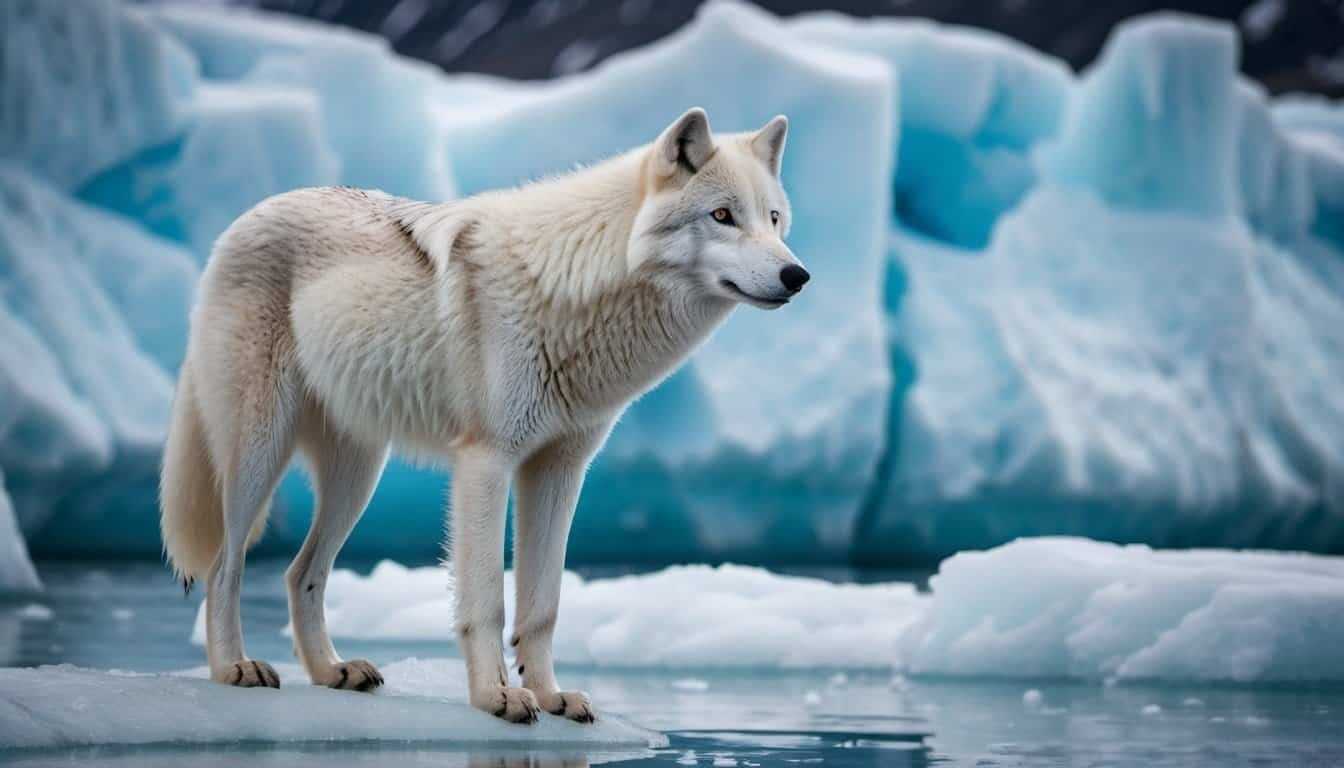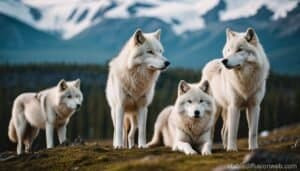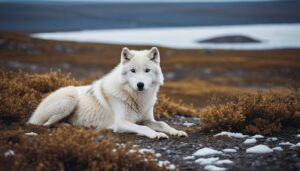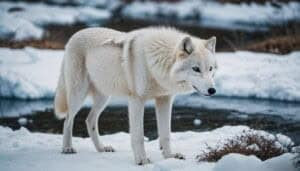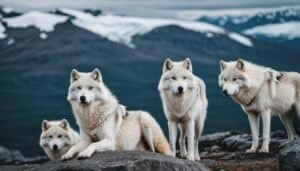Introduction
Climate change has profound effects on the habitat of Arctic wolves, impacting their survival and the Arctic ecosystem
This article explores how decreasing ice levels, rising temperatures, and human activities are altering their environment. It also examines specific threats, potential adaptations, and conservation efforts aimed at safeguarding these iconic predators
By understanding these dynamics, we can better appreciate the challenges faced by Arctic wolves and the importance of protecting their habitat
Effects of Climate Change on Arctic Ice and Ecosystem
Climate change significantly impacts the Arctic environment, leading to a host of changes that affect the entire ecosystem, including Arctic wolves
The reduction in sea ice and the thawing of permafrost are two primary effects of climate change in the Arctic. These changes have a cascading impact on species distribution and biodiversity in the region
Decrease in Sea Ice Coverage
One of the most visible signs of climate change in the Arctic is the rapid decrease in sea ice coverage. Sea ice plays a crucial role in maintaining the Arctic’s unique ecosystem
It provides a platform for species such as seals, which are primary prey for Arctic wolves. As sea ice diminishes, these prey species face habitat loss, leading to a decline in their populations
The reduction in sea ice also means that Arctic wolves must travel greater distances to find food. This increased travel can lead to higher energy expenditure and lower survival rates, especially for younger or weaker wolves
The loss of sea ice also disrupts the wolves’ traditional hunting grounds, forcing them to adapt to new environments that may not be as conducive to their hunting strategies
Impact on Permafrost
Permafrost, or permanently frozen ground, is another critical component of the Arctic landscape that is being affected by climate change. The thawing of permafrost has far-reaching consequences for the entire ecosystem
As the ground thaws, it can lead to the destabilization of the soil, impacting plant life that forms the basis of the food chain
For Arctic wolves, the thawing permafrost can lead to the collapse of dens and other essential structures. This destruction forces wolves to relocate and rebuild in less stable environments
Additionally, the thawing permafrost releases greenhouse gases like methane, further accelerating climate change and creating a feedback loop that exacerbates the initial problem
Changes in Species Distribution
As the Arctic ice and permafrost change, so too does the distribution of species within the region. Some species may move northward in search of cooler climates, while others may face extinction if they cannot adapt quickly enough. This shift in species distribution can disrupt the delicate balance of the Arctic ecosystem
Arctic wolves rely on a specific set of prey species that are well-adapted to the cold environment. As these prey species migrate or decline, wolves may struggle to find sufficient food
This scarcity can lead to increased competition among predators and a potential decline in wolf populations. Furthermore, the introduction of new species into the Arctic can lead to unforeseen ecological interactions that further stress the environment
Impact on Biodiversity
The cumulative effects of decreasing sea ice, thawing permafrost, and changing species distribution all contribute to a reduction in biodiversity in the Arctic. Biodiversity is essential for a resilient ecosystem, providing a buffer against environmental changes and supporting a wide range of ecological functions
For Arctic wolves, a decrease in biodiversity means a loss of potential food sources and a less stable environment. The decline in prey species can lead to malnutrition and decreased reproductive success among wolves
Additionally, a less diverse ecosystem is more vulnerable to diseases and other disruptions, which can have a ripple effect throughout the food chain
Specific Threats to Arctic Wolves
Climate change poses several specific threats to Arctic wolves, primarily through the loss of their natural habitat. As the Arctic environment transforms, these wolves face numerous challenges that jeopardize their survival
The loss of hunting grounds, increased competition for resources, changes in prey populations, and altered migration patterns are some of the most pressing threats
Loss of Hunting Grounds
Arctic wolves are highly adapted to their cold, icy environment, which provides them with unique hunting opportunities. As the sea ice melts and permafrost thaws, these wolves lose significant portions of their hunting grounds
The shrinking ice forces prey species, such as seals and Arctic hares, to migrate or decline in numbers, making it harder for wolves to find food
The loss of hunting grounds not only reduces the availability of prey but also disrupts the wolves’ traditional hunting techniques. Arctic wolves rely on the stability of ice and snow to stalk and ambush their prey
With the changing landscape, these hunting strategies become less effective, leading to lower success rates and higher energy expenditure. This increased difficulty in obtaining food can result in malnutrition and lower reproductive success
Increased Competition for Resources
As prey becomes scarcer due to habitat loss, Arctic wolves face increased competition for the remaining resources. Other predators, such as polar bears and red foxes, may encroach on the wolves’ territory in search of food. This competition can lead to conflicts and reduce the overall availability of prey for Arctic wolves
In addition to competition from other predators, human activities such as commercial fishing and hunting can further deplete the wolves’ food sources. The reduction in fish populations, for instance, can indirectly affect the availability of prey species that depend on these fish
This chain reaction exacerbates the challenges Arctic wolves face in securing enough food to survive
Changes in Prey Populations
Climate change is causing significant shifts in the populations of prey species that Arctic wolves depend on. For example, as temperatures rise, the population of lemmings and Arctic hares, which are crucial for the wolves’ diet, may decline
These species are sensitive to temperature changes and may not be able to adapt quickly enough to the new conditions
Furthermore, the melting sea ice affects marine mammals such as seals, which are also important prey for Arctic wolves. With less ice available for resting and breeding, seal populations are likely to decrease, leading to fewer hunting opportunities for wolves
These changes in prey populations can have a cascading effect on the entire food web, ultimately threatening the survival of Arctic wolves
Altered Migration Patterns
The changing climate is also affecting the migration patterns of various species in the Arctic. Some prey species may migrate earlier or later than usual, or they may shift their migration routes altogether. These alterations can disrupt the timing and location of prey availability, making it more difficult for Arctic wolves to predict and track their food sources
For instance, caribou, another key prey species for Arctic wolves, may alter their migration routes in response to changing vegetation patterns and temperatures
If caribou move to areas where Arctic wolves are not typically found, the wolves may struggle to adapt to these new hunting grounds. This misalignment in migration patterns can lead to periods of food scarcity and increased mortality rates for Arctic wolves
Role of Temperature Increase in Habitat Changes
Rising temperatures are a hallmark of climate change and have profound effects on the Arctic habitat of wolves. These temperature increases impact vegetation, breeding cycles, and overall ecosystem stability
Understanding these changes is crucial to grasping the challenges Arctic wolves face as their environment transforms
Effects on Vegetation
Temperature increases in the Arctic lead to significant changes in vegetation. Warmer conditions enable the growth of shrubs and other plants that were previously unable to survive in the frigid Arctic climate
This shift in plant life can alter the entire food chain, starting with the herbivores that rely on specific types of vegetation
For Arctic wolves, these changes in vegetation can have both direct and indirect impacts. Herbivores like caribou, which are a primary food source for the wolves, may alter their grazing patterns in response to the new plant types. This change can affect the availability and location of prey for Arctic wolves, making it harder for them to find food
Additionally, the growth of new vegetation types can transform the physical landscape, impacting the wolves’ ability to navigate and hunt effectively
Impact on Breeding Cycles
Temperature increases also affect the breeding cycles of Arctic wolves and their prey. Warmer temperatures can lead to earlier springs and longer growing seasons, which may disrupt the timing of breeding and birthing for many species
For Arctic wolves, this can mean a mismatch between the availability of prey and the period when they need the most food to support their pups
Prey species may give birth earlier in the season, leading to a peak in food availability at a different time than when wolf pups are born and require the most nourishment. This temporal mismatch can result in lower survival rates for wolf pups if their parents are unable to find sufficient food
Additionally, warmer temperatures can affect the health and reproductive success of the wolves themselves, potentially leading to smaller litter sizes and lower overall fertility
Adaptation of Arctic Wolves to Climate-Induced Changes
Arctic wolves face significant challenges due to climate change, but they also exhibit remarkable adaptability. These adaptations can be seen in their behavior and genetics, helping them survive in a transforming environment
Understanding these adaptations provides insight into the resilience of Arctic wolves and the ongoing threats they face
Behavioral Adaptations
One way Arctic wolves adapt to climate-induced changes is through behavioral modifications. As their environment shifts, these wolves must adjust their hunting strategies and social behaviors to cope with the new conditions:
Hunting Strategies: Arctic wolves are known for their cooperative hunting tactics, which are essential for taking down larger prey such as caribou. With the loss of traditional hunting grounds and changes in prey availability, wolves may alter their hunting techniques
They might hunt in smaller packs or target different species that are more abundant in the changing environment. For instance, in areas where seals become less accessible due to melting ice, wolves might focus more on terrestrial prey like rodents and birds
Migration and Range Expansion: To find adequate food, Arctic wolves may expand their range or migrate to new areas. This expansion can involve moving further inland or to higher altitudes where temperatures remain cooler and prey availability is higher
Such movements require the wolves to adapt to new terrains and potentially interact with different predator species
Social Structure Adjustments: Changes in prey availability can also impact the social structure of wolf packs. In times of scarcity, packs may break into smaller groups to reduce competition for limited resources
Conversely, in areas where prey is more abundant, packs might consolidate to maximize their hunting efficiency
Genetic Adaptations
In addition to behavioral changes, Arctic wolves may exhibit genetic adaptations that enhance their survival in a changing environment
These adaptations can occur over generations, driven by natural selection as wolves with advantageous traits are more likely to survive and reproduce:
Temperature Tolerance: One potential area of genetic adaptation is the ability to tolerate higher temperatures. Wolves with traits that allow them to better regulate their body temperature in warmer conditions may have a survival advantage
This could include variations in fur density, metabolism, and behavior patterns that reduce heat stress
Dietary Flexibility: Genetic adaptations that allow for greater dietary flexibility can also be crucial. Wolves that can digest a wider variety of food sources, including plants and smaller animals, might have a better chance of surviving in environments where traditional prey is less available
Over time, genetic changes that support a more omnivorous diet could become more prevalent in Arctic wolf populations
Reproductive Timing: Genetic changes can also affect the timing of reproductive cycles to better align with the availability of resources
Wolves with traits that allow them to adjust their breeding season to match peak prey availability might have higher reproductive success. This adjustment can be critical in environments where climate change has altered the timing of prey population booms
Conservation Efforts and Long-Term Projections
The survival of Arctic wolves is closely linked to the effectiveness of conservation efforts and the accuracy of long-term projections. Conservation strategies focus on protecting habitats, mitigating climate change impacts, and ensuring sustainable populations
Long-term projections, while challenging due to the rapidly changing environment, provide a framework for understanding potential future scenarios for Arctic wolves
Protected Areas
Establishing and maintaining protected areas is a cornerstone of conservation efforts for Arctic wolves. These areas provide a refuge where wolves and their prey can thrive without the immediate threats of habitat destruction and human interference:
National Parks and Reserves: Governments and conservation organizations have designated various national parks and wildlife reserves in the Arctic to safeguard critical habitats
These protected areas help preserve the natural environment, ensuring that Arctic wolves have access to the hunting grounds and denning sites they need for survival.
Marine Protected Areas: In addition to land-based reserves, marine protected areas (MPAs) are crucial for conserving the Arctic’s marine ecosystems
MPAs help protect sea ice habitats that are essential for marine prey species such as seals. By maintaining healthy prey populations, these areas indirectly support the survival of Arctic wolves
Indigenous-Led Conservation: Indigenous communities have long played a vital role in Arctic conservation. Their traditional knowledge and sustainable practices are invaluable in managing and protecting wildlife habitats
Collaborative efforts between indigenous groups and conservation organizations can enhance the effectiveness of protected areas
Climate Change Mitigation Strategies
Mitigating the impacts of climate change is essential for the long-term survival of Arctic wolves. While global climate change requires comprehensive international action, specific strategies can help alleviate some of the pressures on Arctic ecosystems:
Reducing Greenhouse Gas Emissions: One of the most effective ways to combat climate change is by reducing greenhouse gas emissions
International agreements like the Paris Agreement aim to limit global temperature rise, which can help slow the melting of Arctic ice and preserve critical habitats for Arctic wolves
Sustainable Development Practices: Promoting sustainable development practices in the Arctic region can minimize environmental damage
This includes regulating industrial activities such as oil and gas extraction, mining, and commercial fishing to ensure they do not harm critical wolf habitats
Research and Monitoring: Continuous research and monitoring of Arctic ecosystems are crucial for understanding the effects of climate change and developing adaptive management strategies
This includes tracking wolf populations, studying prey dynamics, and monitoring habitat changes to inform conservation efforts
Population Decline Predictions
Long-term projections for Arctic wolf populations are complex and depend on various factors, including the success of conservation efforts and the rate of climate change
However, without significant intervention, many projections indicate a decline in Arctic wolf populations due to the loss of habitat and prey:
Habitat Loss: As sea ice continues to melt and permafrost thaws, Arctic wolves are likely to lose significant portions of their habitat. This loss makes it difficult for wolves to find sufficient food and suitable denning sites, leading to potential declines in population numbers
Prey Availability: Changes in prey populations and distribution are also expected to impact Arctic wolf populations. If key prey species such as caribou, seals, and hares decline or migrate out of the wolves’ range, the wolves may face food shortages and reduced reproductive success
Human Impacts: Increased human activities in the Arctic, such as shipping, tourism, and resource extraction, can further threaten wolf populations by disrupting habitats and increasing the risk of human-wolf conflicts
Potential for Recovery
Despite the challenges, there is potential for recovery if robust conservation measures are implemented and climate change impacts are mitigated
Conservation efforts that focus on habitat protection, sustainable development, and climate action can help stabilize and potentially increase Arctic wolf populations:
Adaptive Management: Implementing adaptive management strategies that respond to changing conditions in the Arctic can enhance the resilience of wolf populations
This approach involves continuously monitoring environmental changes and adjusting conservation actions accordingly
Community Engagement: Engaging local communities, including indigenous peoples, in conservation efforts can strengthen the protection of Arctic wolves. Community-led initiatives and co-management practices can ensure that conservation strategies are culturally appropriate and effective
International Collaboration: Global cooperation is essential for addressing the transboundary nature of climate change and its impacts on Arctic ecosystems. Collaborative efforts among countries, conservation organizations, and researchers can amplify the effectiveness of conservation measures
Human Activities and Climate Change Effects
Human activities significantly exacerbate the effects of climate change on the Arctic environment, further threatening the habitat and survival of Arctic wolves. Industrial impact and the challenges faced in conservation efforts due to human activities are crucial areas of concern
Industrial Impact
The Arctic region is rich in natural resources, making it a focal point for various industrial activities. These activities have direct and indirect effects on the habitat of Arctic wolves:
Oil and Gas Exploration: The extraction of oil and gas in the Arctic has led to habitat destruction, pollution, and increased human presence in previously undisturbed areas
Oil spills and leaks can contaminate the environment, affecting the health of wildlife and their prey. Additionally, the infrastructure required for drilling disrupts the natural landscape, making it harder for Arctic wolves to find and hunt prey
Mining Operations: Mining for minerals and metals in the Arctic also poses significant threats to wildlife habitats. The creation of mines, access roads, and waste disposal sites leads to habitat fragmentation and degradation
The noise and pollution from mining activities can disturb the wolves and drive away their prey, leading to food shortages
Shipping Routes: As sea ice diminishes, new shipping routes are opening up in the Arctic, increasing maritime traffic. This rise in shipping activities leads to more pollution, noise, and the potential for ship strikes on marine mammals that wolves rely on for food
The increased human activity also poses the risk of introducing invasive species, which can further disrupt the fragile Arctic ecosystem
Tourism: While Arctic tourism can raise awareness about the region’s environmental issues, it also brings challenges. Increased tourism can lead to habitat disturbance and pollution
Tourists may inadvertently harm wildlife or disrupt their natural behaviors, adding stress to already vulnerable populations
Conservation Challenges
Human activities pose several challenges to effective conservation efforts aimed at protecting Arctic wolves and their habitat:
Limited Accessibility: The remoteness and harsh conditions of the Arctic make it difficult for conservationists to conduct research and implement protective measures
Limited accessibility hampers efforts to monitor wolf populations, assess habitat conditions, and enforce conservation regulations
Regulatory Gaps: The Arctic region spans multiple countries, each with its own regulatory frameworks and conservation priorities
This fragmentation can lead to inconsistent enforcement of environmental protections and gaps in conservation efforts. Effective conservation requires coordinated international policies and cooperation
Economic Pressures: The economic benefits of exploiting Arctic resources can outweigh the perceived importance of conservation. Governments and industries may prioritize economic development over environmental protection, leading to insufficient funding and support for conservation initiatives.
Climate Change Feedback Loops: The effects of climate change in the Arctic create feedback loops that make conservation more challenging
For example, the thawing of permafrost releases greenhouse gases, further accelerating climate change and its impacts. These feedback loops complicate efforts to stabilize the environment and protect wildlife
Indigenous Rights and Involvement: Indigenous communities have a vital role in Arctic conservation, but their rights and knowledge are not always fully recognized or integrated into conservation strategies
Ensuring that indigenous peoples are active partners in conservation efforts is essential for creating sustainable and culturally appropriate solutions
Conclusion
Climate change has a profound impact on the habitat of Arctic wolves, presenting numerous challenges that threaten their survival. The reduction in sea ice and thawing permafrost, driven by rising temperatures, lead to habitat loss and changes in species distribution, significantly affecting the biodiversity of the Arctic ecosystem
These environmental shifts create specific threats for Arctic wolves, such as the loss of hunting grounds, increased competition for resources, and alterations in prey populations and migration patterns
Despite these challenges, Arctic wolves exhibit remarkable behavioral and genetic adaptations, allowing them to navigate and survive in a rapidly changing environment. However, the effectiveness of conservation efforts is crucial to their long-term survival
Establishing protected areas, implementing climate change mitigation strategies, and engaging in adaptive management practices are essential steps in safeguarding Arctic wolves
Human activities, including industrial operations and increased shipping and tourism, further exacerbate the effects of climate change, making conservation efforts more challenging. Addressing these issues requires coordinated international action, effective regulatory frameworks, and the integration of indigenous knowledge and practices
In conclusion, the future of Arctic wolves depends on our ability to mitigate climate change impacts, protect their habitat, and implement sustainable conservation strategies. By understanding and addressing the multifaceted challenges posed by a warming Arctic, we can work towards ensuring the survival and resilience of these iconic predators
